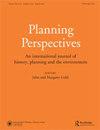La città degli igienisti. Riforme e utopie sanitarie nell’Italia umbertina [The city of hygienists. Health reforms and utopias in Umbertine Italy]
IF 0.9
3区 历史学
0 ARCHITECTURE
引用次数: 0
Abstract
In 1989, Guido Zucconi published La città contesa (The disputed city), a book that quickly became a key reference for Italy’s planning historians. Here Zucconi traced the debates on cities in Italy between the late nineteenth century and the Second World War, focusing on the competition between important cultural and professional figures and the changing ways of understanding urban challenges. The book shows how early positivist approaches to urban reform based on statistical and medical knowledge over time were supplanted by approaches connected with the leadership of architects-planners, hybrid figures that had emerged from the newly created schools of architecture and capable of blending artistic, historical, and technical expertise. More than three decades after, in La città degli igienisti, Zucconi returns to the same topic by developing what was originally the first chapter of his inquiry, dedicated to the ‘hygienists’. His new research is a highly detailed and documented analysis of the emergence of urban hygiene in late nineteenth-century Italy, set within the context of European policies, practices, and theories. The work focuses on the reign of king Umberto I (1878-1900) and, more specifically, on the period during which Francesco Crispi was head of government (1887-91 and 1893-96). Under Crispi’s rule, Italy promoted several ambitious reforms regarding public health and hygiene, with the approval of a general law on the matter (1888) and the incorporation of a state direction and a specialization school. A key personality behind such initiatives was Luigi Pagliani, a professor at the University of Turin who defended the idea that ‘sanitary engineers’ were to become central figures in Italy’s newly designed system. These future experts – neither physicians nor engineers, but a mixture of both – were called to contribute to an all-embracing renovation of the built environment according to scientific principles. Over the course of the nineteenth century, public hygiene had been chiefly an urban issue. Italy was touched by several waves of cholera epidemics, which led, for example, to the approval of a hygiene law for Naples in 1885. The law put in place special measures to facilitate the demolition and reconstruction of urban sectors deemed unhealthy. Other municipalities were able to take similar measures, as this law was instrumental in the diffusion of neo-Haussmannian strategies of slum clearance. Zucconi shows how these interventions were supported by a plurality of tools for urban analysis and reform, such as the systematic collection of statistical information, the identification and mapping of emerging diseases, and the elaboration of new building regulations. The municipal reform passed in 1889 introduced specific competencies within city administrations, which were asked to draft hygiene regulations and put in place dedicated bureaucracies. The book offers a rich and nuanced analysis of Crispi’s reforms and the premises upon which they rested. It describes different aspects of the hygiene initiatives at the end of the nineteenth century in great detail, including activities connected to university chairs, congresses, associations, journals and scientific publications. It dedicates strong attention to medical academic practices and theories, showing that Italy’s path to hygienics emerged from the fields of physiology and pathological anatomy. Zucconi emphasizes the influence of Dutch physician Jacob Moleschott, who taught at the University of Turin from 1861 and promoted an experimental, evidence-based approach to the study of disease. The book also clarifies how the positions of Luigi Pagliani, one of Moleschott’s students, were far from unchallenged. Hygiene specialists such as Angelo Celli, for example, defended the alternative idea that public health should firmly remain a specialized sub-sector within medical research. In the field of urban planning, architects sensitive to historical and preservation issues, such as Camillo Boito, repeatedly opposed the insensitive attitude toward heritage displayed by sanitary schemes.卫生之城。意大利umbertina的改革和卫生乌托邦。意大利Umbertine的健康改革与乌托邦
1989年,Guido Zucconi出版了《争议城市》,这本书很快成为意大利规划历史学家的重要参考。在这里,Zucconi追溯了19世纪末至第二次世界大战期间意大利关于城市的辩论,重点关注重要文化和专业人物之间的竞争以及理解城市挑战的方式的变化。这本书展示了随着时间的推移,基于统计和医学知识的早期实证主义城市改革方法是如何被与建筑师和规划者的领导层相关的方法所取代的,建筑师和规划者是从新创建的建筑学院中产生的混合人物,能够融合艺术、历史和技术专业知识。三十多年后,在La cittàdegli igienisti,Zucconi又回到了同一个话题,他开发了最初是他调查的第一章,专门针对“卫生学家”。他的新研究是在欧洲政策、实践和理论的背景下,对19世纪末意大利城市卫生的出现进行的高度详细和有记录的分析。这部作品聚焦于翁贝托·一世国王的统治时期(1878-1900年),更具体地说,是弗朗切斯科·克里斯皮担任政府首脑期间(1887-91年和1893-96年)。在克里斯皮的统治下,意大利推动了几项关于公共卫生和个人卫生的雄心勃勃的改革,批准了一项关于这一问题的一般法律(1888年),并设立了一个国家指导和一所专业学校。这些举措背后的一个关键人物是都灵大学教授路易吉·帕格里亚尼,他为“卫生工程师”将成为意大利新设计系统的核心人物的想法进行了辩护。这些未来的专家——既不是医生也不是工程师,而是两者的混合体——被要求根据科学原则为建筑环境的全面翻新做出贡献。在十九世纪,公共卫生主要是一个城市问题。意大利受到了几波霍乱疫情的影响,例如,1885年批准了那不勒斯的卫生法。该法律制定了特别措施,为被认为不健康的城市部门的拆除和重建提供便利。其他城市也能够采取类似措施,因为这项法律有助于推广新奥斯曼式的贫民窟清理战略。Zucconi展示了这些干预措施是如何得到多种城市分析和改革工具的支持的,例如系统收集统计信息、识别和绘制新出现的疾病以及制定新的建筑法规。1889年通过的市政改革引入了城市行政部门的特定权限,要求其起草卫生条例并建立专门的官僚机构。这本书对克里斯皮的改革及其所依据的前提进行了丰富而细致的分析。它详细描述了19世纪末卫生倡议的不同方面,包括与大学主席、大会、协会、期刊和科学出版物有关的活动。它高度重视医学学术实践和理论,表明意大利的卫生之路是从生理学和病理解剖学领域走出来的。祖科尼强调了荷兰医生雅各布·莫莱斯科特的影响,他从1861年起在都灵大学任教,并推广了一种基于证据的实验方法来研究疾病。这本书还阐明了莫勒肖特的学生之一路易吉·帕格里亚尼的立场远未受到质疑。例如,Angelo Celli等卫生专家为另一种观点辩护,即公共卫生应始终是医学研究中的一个专门子部门。在城市规划领域,对历史和保护问题敏感的建筑师,如Camilo Boito,一再反对卫生方案对遗产表现出的不敏感态度。
本文章由计算机程序翻译,如有差异,请以英文原文为准。
求助全文
约1分钟内获得全文
求助全文
来源期刊

Planning Perspectives
Multiple-
CiteScore
1.50
自引率
12.50%
发文量
85
期刊介绍:
Planning Perspectives is a peer-reviewed international journal of history, planning and the environment, publishing historical and prospective articles on many aspects of plan making and implementation. Subjects covered link the interest of those working in economic, social and political history, historical geography and historical sociology with those in the applied fields of public health, housing construction, architecture and town planning. The Journal has a substantial book review section, covering UK, North American and European literature.
 求助内容:
求助内容: 应助结果提醒方式:
应助结果提醒方式:


